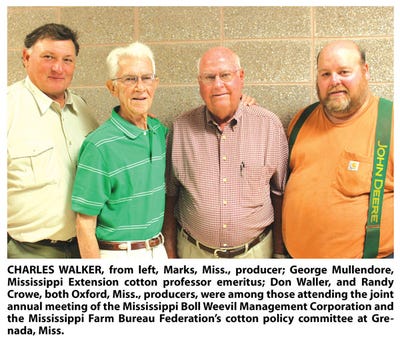
“It looks like Texas is turning into a desert state,” says Carl G. Anderson, and the ongoing severe drought will have an adverse impact on what had promised to be a huge cotton production year. “At this time,' he says, "I’d estimate that 3 million of the 7.1 million acres planted this season will be abandoned — the largest abandonment since 1981.”

“It looks like Texas is turning into a desert state,” says Carl G. Anderson, and the ongoing severe drought will have an adverse impact on what had promised to be a year of significant rebound in U.S. production.

The Texas losses, which could be 35 percent or more of this year’s 7.1 million planted acres, will also mean a smaller U.S. crop, according to the Texas A&M Extension professor emeritus, who discussed the situation via teleconference for the joint annual meeting of the Mississippi Boll Weevil Management Corporation and the Mississippi Farm Bureau Federation’s cotton policy committee.
“At this point (July 7), 91 percent of Texas is under extremely dry or exceptionally dry conditions. The situation is serious for all crops, including forage and hay. There is no situation in recent times comparable to what we’re seeing this year.
“In the Coastal Bend area, there has been very little rain since about October 1. From Jan. 1 through June, the area had only 1 to 2 inches of rain, less than half what it had in prior droughts..
“I was in the Corpus Christi area about two weeks ago and the cotton looked very puny, with white blooms all across the top. The best I saw might squeak out a bale per acre dryland, compared to two bales in most years.”
 Northeast of Austin, growers are already zeroing out cotton, Anderson says. “From Waco north to Oklahoma, they have a decent crop, but there’s only about 100,000 acres in that region.
Northeast of Austin, growers are already zeroing out cotton, Anderson says. “From Waco north to Oklahoma, they have a decent crop, but there’s only about 100,000 acres in that region.
“We’ve got 1 million acres east of the I-35 corridor, but it’s going to be tough for it to make a bale per acre, and I’d think 400 lbs. would be more likely.
“In the West Texas area, there’s simply nothing to talk about for dryland cotton — they’re already zeroing it out.
Major acreage abandonment
Millions of acres will be abandoned in Texas, Anderson says.
“At this time, I’d estimate that 3 million of the 7.1 million acres planted this season will be abandoned — the largest abandonment since 1981.”
Much of the state’s irrigated cotton depends on getting some rainfall during the season to help the crop along, Anderson notes, and the lack of rain this year will also hurt the irrigated crop.
“Last year, we made 2 bales per acre, 1,000 pounds of lint, on our irrigated land. If we don’t start getting some rains to supplement irrigation, that crop will be, at best, 1.5 bales. Some farmers are saying irrigated land will produce only a bale per acre.”
The June 30 USDA report shows just how much impact $1-plus cotton had on planted acres, he says.
“The 7.1 million acres planted this year was a huge increase increase over the 5.5 million acres in 2010. But with Texas standing to lose 35 percent of this year’s crop to the drought, the huge increase in planted acres is not going to contribute much to the rebuilding of U.S. stocks.
“We could easily have made 8.5 million bales on this year’s planted acreage, but now we’re looking at maybe half a crop — 4 million to 5 million bales.”
Other crops are suffering, too, Anderson says.
“We’ve got corn in the Blacklands up around El Campo that appraisers are saying will produce zero to 15 bushels per acre. We don’t expect much out of this year’s dryland corn crop. There’s about half a crop in the Panhandle, but it’s mostly irrigated. Our wheat crop was only about 25 percent of normal.
“So, the crop outlook in Texas for 2011 is not very good. Thank goodness for the insurance programs, even though the federal crop insurance program can stand a lot of improvement. I’m also told the planting seed companies will be adjusting the cost of seed and technology fees on abandoned acres.”
Other states in the Southwest and across the South also have areas of drought, Anderson notes, and “with Texas’ huge losses, we could be looking at a U.S. crop of only 16 million to 16.5 million bales. We’re also looking at a weak export market, maybe in the 11 million to 12 million bale range, down from 15 million.”
Larger world crop expected
Looking at the world situation, he says Brazil, Argentina, Australia, and other southern hemisphere countries are making good crops and feeding that cotton into the market. Pakistan’s cotton crop is looking very good after last year’s disaster, he says.
“This year, we’re looking at a big increase in world production, maybe as much as 10 million to 12 million bales over 2010. Even with the most optimistic usage figures, we’re going to see production exceed usage by 8 million to 12 million bales..
“In the past, when we’ve seen a big increase in the world price of cotton, we’ve also seen a big slowdown in world use. My thinking is that we’ll see about a 1 million bale carryover in the U.S. crop and about 10 million bales for the world crop.
“This would point to a price of about $1.15 for December 2011 cotton. We’re at $1.13 today, a big drop from the $1.40 range in June.
“December 2011 has had strong support at $1.15, but it looks like the market wants to slip down through that, and my concern is where the low end of the price range will be — that we could test the $1 level if we don’t get an under-16 million bale crop.”
It will depend, Anderson says, on how this year’s U.S. and world crops unfold.
“Short term, I think we’ll see a range of $1.10 to $1.20, and in the longer run from $1 to $1.25. Under a worst case scenario, we could see December 2011 slip below $1.
“Much of what we’ve seen with $1-plus prices has been driven by non-market users — I call them speculators — and it bothers me no end that we can see the market go up simply because a lot of funds come in on the buy side.
“My hope is that we can hold the price at 90 cents or better, or it will below our cost of production.
I’m very concerned,” Anderson says, “when I walk through clothing stores and see men’s dress shirts that are 50 percent polyster/50 percent cotton, where I used to see 100 percent cotton. I think this is where high prices have hurt our export demand and our China demand, causing mills to shift over to man-made fibers. And that business may not come back quickly.”
About the Author(s)
You May Also Like



